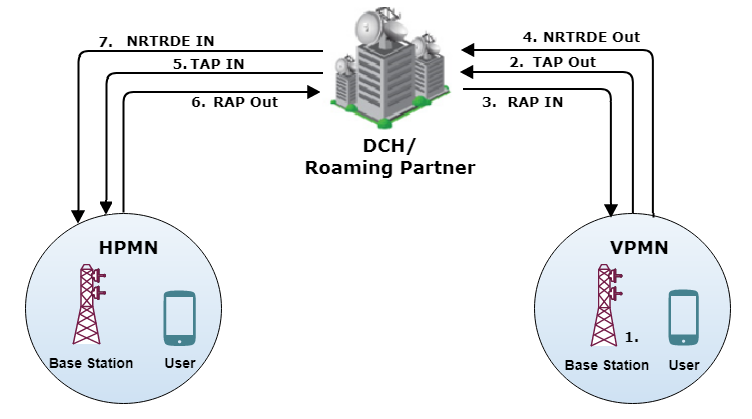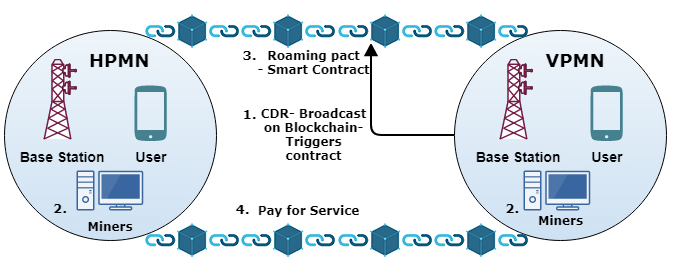The blockchain infrastructure has the potential for instant value transfer, reconciliation and settlement of cryptographically secured transactions through smart contracts between all parties involved.
Let me put forward one of the compelling economic Use-case in Telecom Roaming Billing and settlement which shows the true potential of "Decentralization and Disintermediation" capability of Blockchain.
Before we move to the use case, let us try to first understand abbreviations used in this article.
HPMN: The Home Public Mobile Network is the network from the operator by which a mobile subscriber has a subscription.
VPMN: The Visited Public Mobile Network is the network used by a mobile subscriber while roaming.
TAP: Transferred Accounts Procedure (TAP) is the procedure that allows VPMN to provide billing records of roaming subscribers to their respective HPMN.
RAP: Returned Accounts Procedure (RAP) defines the format for returning information on errors found within transferred TAP files/events.
DCH: Data Clearing Houses are external bodies interface between different roaming partners to help them to exchange their CDRs, setting up roaming agreements and resolving any dispute.
NRTRDE: Near Real Time Roaming Data Exchange (NRTRDE) is CDR interchange to monitor customers’ activities in the VPMN networks.
CDR: Call Data Record.
AS-IS Business Process: Billing and settlement between the Roaming Partners.
Below diagram depicts flow for exchanging roaming billing records (of a mobile roamer) between two roaming partners.

Let us understand the series of event depicted in above diagram:
1: VPMN rates the call and event records for subscriber of home network who visited into foreign network.
2: VPMN create TAP(OUT) file based GSM standards and sends to DCH based on agreed frequency and within number of files specified by standard.
3: DCH validates the TAP(OUT) files and generates the RAP(IN) files, sends to VPMN if there is errors found in the TAP(OUT) files as per the agreement.
4: VPMN also send the NRTRDE files to DCH for monitoring subscriber activities in visitor network.
5: DCH sends the TAP(IN) files to HPMN to rate the subscriber for using the Foreign Network services.
6: HPMN validates the TAP(IN) files and generates RAP(OUT) files , sends to DCH if there is errors found in the TAP(IN) files as per the agreement.
7: DCH also send the NRTRDE files received in Step-4 to HPMN DCH for monitoring subscriber activities in visitor network.
Disadvantages of offline Transfer Account Procedure:
1: Both HPMN and VPMN has to pay hefty fees to DCH as central authority to execute the contract for Roaming services.
2: Roaming rated CDR being exchanged in terms of TAP files in offline mode.
3: There is high chances of disputes being raised between VPMN and HPMN since the exchange of billing records are offline.
4: The dispute resolution process is also offline executed by DCH by validating the CDRs and contracts of both the partners.
5: The offline process of TAP leads to delay in billing and hence revenue sharing among the roaming partners.
Block Chain Alternative Solution:
A permissioned blockchain could be implemented between every pair of operators which have a roaming agreement.

Let us understand the Series of event in above diagram:
1 : Every time a subscriber triggers an event in a visiting network, the VPMN broadcasts the CDR information as a transaction to the HPMN.
2: Designated nodes from both operators act as miners to verify the sanctity of each transaction broadcasted on the network as per the roaming agreement.
3: The roaming agreement is implemented between the HPMN and the VPMN as a smart contract that is triggered when a transaction containing the CDR data is broadcasted on the blockchain network.
There could be several contracts on the network each representing function to be implemented.
* Validation of CDR sent by VPMN to HPMN based on defined agreement.
* Early detection of fraud by monitoring services used in VPMN based on agreement.
* Inter operator tariff application/validation of usage in VPMN.
After all the contracts have been executed and the charge for that call/usage has been computed, the final output is sent as a transaction to the HPMN.
4: The HPMN can thus automatically initiate the transaction to pay the charges for the services rendered and pay that particular transaction ( in real time or on scheduled frequency) to the VPMN.
Advantages of Near-real-time Blockchain transactions:
1: The instantaneous settlement using blockchain-based smart contract takes away the offline billing information exchange between roaming partners through DCH.
2: CSPs can also do away with the DCH acting as middleman, resulting in further cost savings.
3: Automatic triggering of roaming contract based on call/event data which enables near-instantaneous charging and reduction in roaming fraud.
4: Repository of verifiable transactions between operators, allowing for quick dispute resolution.
5: This blockchain based implementation can be scaled to any number of partners and any number of contracts between the partners.
What could be other advantages of this blockchain based implementation ?
What do you think about the feasibility of this application ?
Let me know your view on above questions... Happy reading!!!




















